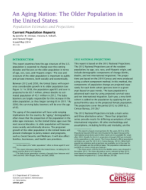An Aging Nation: The Older Population in the United States
An Aging Nation: The Older Population in the United States
Abstract
This report examines how the age structure of the U.S. population is expected to change over the coming decades and focuses on the older population in terms of age, sex, race, and Hispanic origin. The size and structure of the older population is important to public and private interests, both socially and economically.
Between 2012 and 2050, the United States will experience considerable growth in its older population (see Figure 1). In 2050, the population aged 65 and over is projected to be 83.7 million, almost double its estimated population of 43.1 million in 2012. The baby boomers are largely responsible for this increase in the older population, as they began turning 65 in 2011. By 2050, the surviving baby boomers will be over the age of 85.
The aging of the population will have wide-ranging implications for the country. By “aging,” demographers often mean that the proportion of the population in the older ages increases. As the United States ages over the next several decades, its older population will become more racially and ethnically diverse. The projected growth of the older population in the United States will present challenges to policy makers and programs, such as Social Security and Medicare. It will also affect families, businesses, and health care providers.
Others in Series
Publication
Publication
Publication




